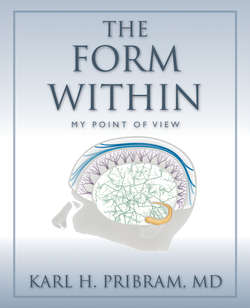Читать книгу The Form Within - Karl H Pribram - Страница 39
На сайте Литреса книга снята с продажи.
Chapter 4 Features and Frequencies
ОглавлениеWherein I juxtapose form as shape and form as pattern as they are recorded from the brain cortex and describe the usefulness and drawbacks of each.
We live in a sea of vibrations, detecting them through our senses and forming impressions of our surroundings by decoding information encrypted in these fluctuations.
—Ovidiu Lipan, “Enlightening Rhythms,” Science, 2008
It sometimes appears that the resistance to accepting the evidence that cortical cells are responding to the two-dimensional Fourier components of stimuli {is due} to a general unease about positing that a complex mathematical operation similar to Fourier analysis might take place in a biological structure like cortical cells. It is almost as if this evoked, for some, a specter of a little man sitting in a corner of the cell huddled over a calculator. Nothing of the sort is of course implied: the cells carry out their processing by summation and inhibition and other physiological interactions with their receptive fields. There is no more contradiction between a functional description of some electronic component being a multiplier and its being made up of transistors and wired in a certain fashion. The one level describes the process, the other states the mechanism.
—Russell DeValois and Karen DeValois, Spatial Vision, 1988
In this chapter I detail for the visual system the difference between the two modes of scientific exploration discussed in earlier chapters. One of these modes explores form as shape, while the other explores form as pattern. Features can be thought of either as building blocks that determine the shape of our environment or as components of perceived patterns that we as, sentient, conscious, beings choose to focus on.
Within the research community the contrast between these two views of perception was wittily joked about as pitting “feature creatures” against “frequency freaks.” Feature creatures were those who focused on “detectors” within our sensory systems, of features in our external environment —a purely “bottom-up” procedure that processes particulars into wholes. Frequency freaks, by contrast, focused on similarities between processes in the visual mode and those in the auditory (and incidentally the somatosensory) mode. For the frequency freaks, the central idea was that our visual system responds to the spectral, frequency dimension of stimulation very much as the auditory system responds to the oscillations that determine the pitch and duration of sound. The approach of the frequency freaks, therefore, is “top-down”—wholes to particulars. Within the neuroscience community, the feature creatures still hold the fortress of established opinion, but frequency freaks are gaining ascendance with every passing year.
